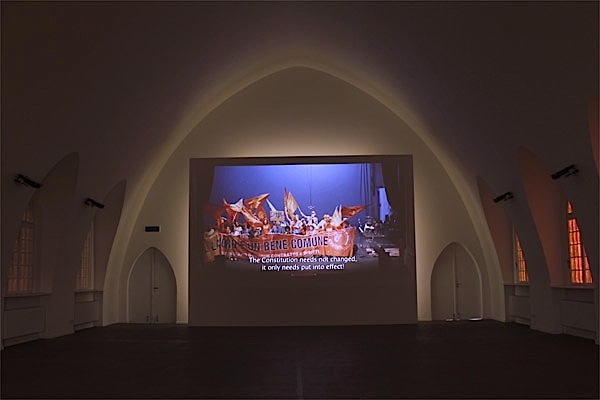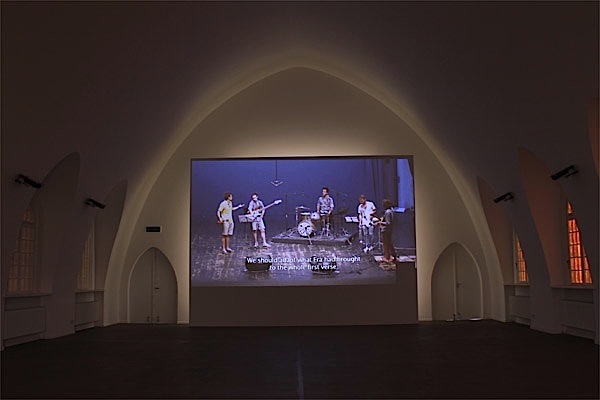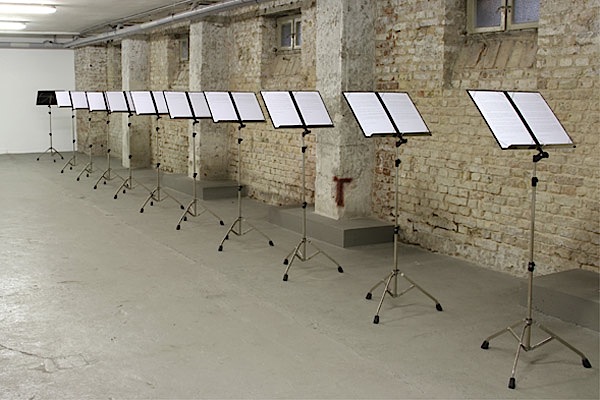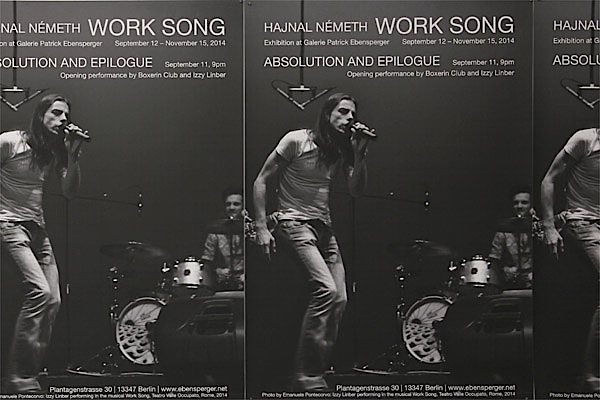WORK SONG #1/2
2014
exhibition, Galerie Patrick Ebensperger, Berlin
2014
exhibition, Galerie Patrick Ebensperger, Berlin




Galerie Patrick Ebensperger presented the exhibition Work Song in the former Crematory in Berlin-Wedding from September 12th until November 15th, 2014.
...
The musical Work Song has been originally produced and presented in the same year at Teatro Valle Occupato in Rome. Among other works the exhibition includes a video documentation of the musical’s opening night.
The main issue of the piece is the unemployment in Italy, the content of the primary textbook and the lyrics of the songs are based on interviews and researches in the region of Rome. The musical divided in three parts can be considered experimental in the sense that it is a self-reflective performance querying theatre as an expressive form and also the genre of musical itself. In other words it is an avant-garde show based on reality. Beyond its self-reflective nature, in terms of form, it is an amalgam of genres, a process-based piece comprised of the formal elements of visual arts, music, theatre, and formal elements of a demonstration or a psychodrama. The piece itself is made up of improvisations developed during rehearsals, constructed on a basic framework comprising a schematic narrative and instructions.
The single essential story of the piece unfolds in the scope of a psychodrama from the future in 2032, by evoking the childhood trauma of the protagonist, which happened in 2013. The recollected tragedy is thus a current story, and is based in actual events: the circumstances of the suicide of a man in his final desperation at having become unemployed. The story is delivered from the point of view of the deceased family man’s niece, from a distance of 19 years.
The lyrics of the musical’s fundamental composition are written in two versions with opposite meanings entitled Work Song and Absolution. At the opening of the exhibition the last act of the musical - Absolution and Epilogue – was performed live: a band rehearsal on stage, during which the lyrics of the song Absolution are transcribed into the lyrics of Work Song.
...
Beside the video of the musical the exhibition presented the following works from the artist: Crash – Passive Interview (2011), The Loser (2012), False Testimony – Version 3 (2013), Imagine War (2014)
Crash – Passive Interview (2011) is an experimental opera based on 12 retold stories of car accidents using the dialogical form, narrated in utmost minute detail and slowed down by memory. The relation of man to drive shows an inclination of the fetishism towards technical objects. The video of the operatic performances was presented for the first time at the 54th International Art Exhibition - la Biennale di Venezia, at the Hungarian Pavilion.
In the video The Loser (2012) two confessional monologues are sung between a politician and a banker, performed by four soloists and completed with self-introductions by a choir. The lyrics of the songs are based on shortened and rhythmical accounts of fallen leaders driven by feeling of devotion, the experience of struggle and power, the ignorance of responsibility between the individual and the collective, the faith in ideologies and its gradual loss. The characters are different but the outcome is the same. The degeneration and downfall from the initial enthusiasm are therefore related elements in these testimonies.
False Testimony (2013) is an installation including objects, photographs and a video of a choir performance. The matter of this work is the Tiszaeszlár Trial of 1883. Following the disappearance of a 14-year-old girl Eszter Solymosi on April 1, 1882, in the Hungarian village of Tiszaeszlár, local rumors and suspicions of Jewish ritual murder led to a high-profile murder case in the summer of 1883. The trial was closely interwoven with the birth of modern antisemitism in Hungary: shortly after the verdict and a spate of antisemitic riots around the country, Hungary’s first National Antisemitic Party (1883-1892) was formed. “Tiszaeszlár” later became an important element in the radical Right’s historical narrative and subsequent constructions of national martyrology. The series of photographs entitled “Loud Place” documents the contemporary right-wing cult of Eszter Solymosi and the grave erected in her honor in 1994. The photo “Silent Place 1” shows the former courtroom in its empty state, while “Silent Place 2” shows the Jewish cemetery in Tiszaeszlár which, today, is unmarked, and enclosed by a concrete wall. The central pieces of the exhibition, use the transcript of Miklós Erdély’s classic 1981 film “Verzió” to rework one of the key scenes of the trial. In these video, a choir and 3 soloists are performing one versions of the scene in which the prosecution’s witness, 14-year-old Móric Scharf, is trained to confess, which confession he later repeats over and over. Hajnal Németh by reenacting the story directs attention to the present. She realizes a version whose framework is no longer late 19th century Hungary, but a present-day place, a library of an archives. The art work examine individual and collective memory and identity, the Processes of psychological and cultural acquisition, and the learning of antisemitic witness and national martyrology.
Imagine War (2014) is a concert performance based on rewritten lyrics of famous hist and sung by a solo performer. The alteration of the most significant words transform the meaning of the original songs. The transcriptions are interpreted by the performer in his own special musical way, this pushes the borders between memory and consciousness one step further.
...
...
Photos: Hajnal Nemeth